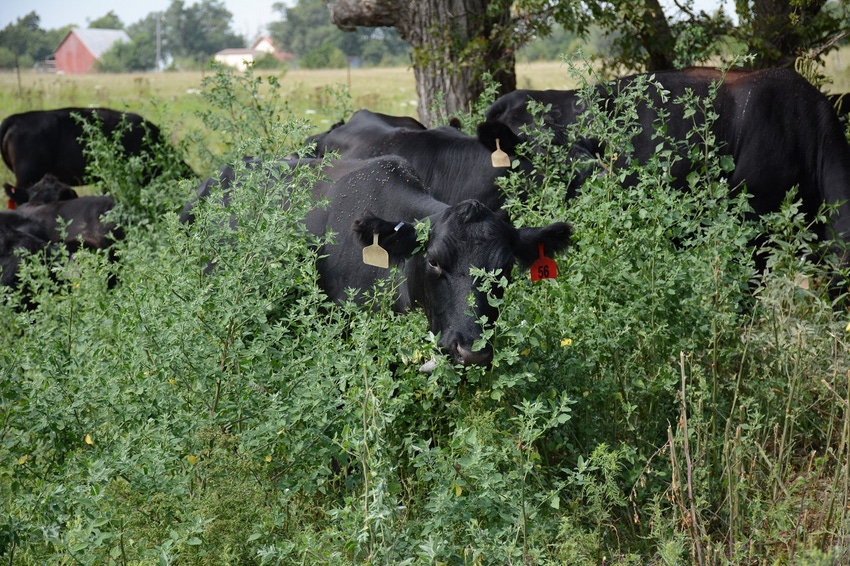
The science on grass-finished beef nutrition has included one conflicting report after another, with unclear human health benefits, but a new paper sheds light on how beef from ecologically diverse environments may offer those desired health improvements.
A recently published paper in Frontiers in Nutrition by Fred Provenza and two other scientists suggests strong ties between secondary and tertiary nutrients in foods and human health. Provenza is professor emeritus at Utah State University and throughout his career pioneered much work on animal nutritional behavior. Their paper, titled "Is Grassfed Meat and Dairy Better for Human and Environmental Health?" has a lengthy bibliography supporting their suppositions.
The paper summarizes: "Strong circumstantial evidence supports the hypothesis that plant diversity, manifest as phytochemical richness of landscapes, is essential for biochemical richness of meat and dairy, which is fundamental for human and environmental health."
One of the things that has intrigued Provenza for some years is his discoveries about how animals possess "nutritional wisdom," meaning the ability to generally choose healthy food types and balances, including consumption of medicinal compounds. The more diverse the habitat they live in, the better job they do of these selections. Yet humans, with seemingly unending food choices, almost appear to have lost these abilities, or perhaps never had them. In fact, Provenza has said over recent years there is potentially more evidence humans have become confused than there is that they have no nutritional wisdom. Our tastes have been confused by processed food, imbalances and acclimation to "bland diets," he says.
That notwithstanding, this new paper notes several important nutritional connections between diverse habitats, the grazing livestock that live on them, and the health of the livestock and the humans who eat animal-based food products from those critters.
"Phytochemical richness of herbivore diets increases markedly from livestock fed cereal grains in feedlots to grain-pasture mixtures to botanically diverse pastures," the authors wrote. "Yet, epidemiological and ecological studies critical of red meat consumption do not discriminate among meats from livestock fed high-grain rations versus livestock foraging on landscapes of increasing phytochemical richness. We found much circumstantial evidence to support the hypothesis that phytochemical richness of herbivore diets influences biochemical richness of meat and dairy and human and environmental health."
Besides their documented and hypothesized health benefits, biochemically diverse foods have other advantages, the authors said. They noted when phytochemically rich herbs and spices are added in trifling amounts to foods, they enhance palatability, satiation (when a meal ends), and satiety (length of time between meals). Besides the biofeedback from human bodies saying the need for certain nutritional compounds is fulfillied, people also eat less when food provides more sensory pleasure than they do when consuming a blander version of the food. All this results from a complex system of biofeedback in the human body, similar to the way animals choose plant compounds.
Here are a few more of the findings from this literature review.
Phytochemically rich diets for herbivores and biochemically rich diets for humans include not only so-called primary compounds such as energy, protein, minerals and vitamins, but a host of so-called secondary compounds—including but not limited to phenolics, terpenoids, and alkaloids. All have health benefits, though most can be toxic in excess.
Animals living in and attuned to a diverse landscape are good at meeting their nutritional needs and at self-medicating. On monoculture pastures or simple plant mixtures, however, they are much less able to do so. Same with feedlots where they eat only total mixed rations.
Animals attuned to a diverse habitat are healthier than those unattuned, or those living in simplified habitats.
Animals foraging on phytochemically diverse pastures require less anthelmintics and antibiotics than those in feedlots or foraging on monoculture pastures.
Herbivore diets influence the flavor and biochemical richness of meat and dairy such that laboratory analyses can distinguish animals eating diets of increasing phytochemical richness, ranging from cereal grains to grain-pasture mixes to pastures. For example, tannins in herbivore diets improve the flavor of meat by reducing rumen bacteria that produce "off-flavors" from skatole, a mildly toxic organic compound produced from tryptophan in the mammalian digestive tract, and they affect rumen biohydrogenation of polyunsaturated fatty acids, which changes fatty acid profiles in meat. Human can taste these compounds, as well.
People unaccustomed to biochemical richness may not care for these flavors, but those accustomed to eating such products prefer them.
As for the evidence meats cause systemic inflammation, the researchers showed when herbivores eat phytochemically rich diets, compounds in their diets protect their meat and dairy products from the protein oxidation and lipid peroxidation that cause inflammation when consumed in human diets.
Even without beef originating from diverse pastures, the authors noted a study showing the biochemical richness of red wines can have an anti-inflammatory effect when consumed together with beef. "Postprandial plasma levels of MDA rise by three-fold after a meal of red meat cutlets, but drinking polyphenol-rich red wine along with cutlets reduces levels of MDA by 75%," the authors noted in quoting 2008 research.
They also noted three studies that showed eating antioxidant-rich fruits and vegetables along with a high-fat meal improves vascular function and thwarts the negative effects of fat on endothelial function (these are the cells that line the interior of blood vessels).
Ultimately, Provenza and other researchers are showing us the simplification for which modern agriculture has such a penchant is counter-productive.
A similar story you might like to read is Good soils build better beef, better food.
About the Author(s)
You May Also Like




